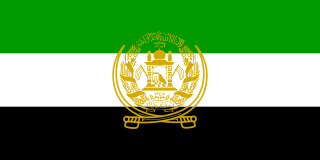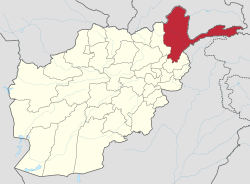
Burhānuddīn Rabbānī was an Afghan politician and teacher who served as President of Afghanistan from 1992 to 1996, and again from November to December 2001.

The Taliban, which also refers to itself by its state name, the Islamic Emirate of Afghanistan, is a militant Pashtun nationalist organization in Afghanistan with close ties to Deobandi Islamic fundamentalism. It ruled approximately three-quarters of the country from 1996 to 2001, before being overthrown following the American invasion. It recaptured Kabul on 15 August 2021 following the departure of most coalition forces, after nearly 20 years of insurgency, and currently controls all of the country. However, its government is not recognized by any country. The Taliban government has been internationally condemned for restricting human rights in Afghanistan, including the right of women and girls to work and to have an education.

The Islamic Emirate of Afghanistan, also referred to as the First Islamic Emirate of Afghanistan, was a totalitarian Islamic state led by the Taliban that ruled most of Afghanistan from 1996 to 2001. At its peak, the Taliban government controlled approximately 90% of the country, while remaining regions in the northeast were held by the Northern Alliance, which maintained broad international recognition as a continuation of the Islamic State of Afghanistan.

Nuristan, also spelled as Nurestan or Nooristan, is one of the 34 provinces of Afghanistan, located in the eastern part of the country. It is divided into seven districts and is Afghanistan's least populous province, with a population of around 167,000. Parun serves as the provincial capital. Nuristan is bordered on the south by Laghman and Kunar provinces, on the north by Badakhshan province, on the west by Panjshir province.

Badakhshan Province is one of the 34 provinces of Afghanistan, located in the northeastern part of the country. It is bordered by Tajikistan's Gorno-Badakhshan in the north and the Pakistani regions of Lower and Upper Chitral and Gilgit-Baltistan in the southeast. It also has a 91-kilometer (57-mile) border with China in the east.

The Northern Alliance, officially known as the United Islamic National Front for the Salvation of Afghanistan, was a military alliance of groups that operated between late 1996 to 2001 after the Islamic Emirate of Afghanistan (Taliban) took over Kabul. The United Front was originally assembled by key leaders of the Islamic State of Afghanistan, particularly president Burhanuddin Rabbani and former Defense Minister Ahmad Shah Massoud. Initially, it included mostly Tajiks but by 2000, leaders of other ethnic groups had joined the Northern Alliance. This included Karim Khalili, Abdul Rashid Dostum, Abdullah Abdullah, Mohammad Mohaqiq, Abdul Qadir, Asif Mohseni, Amrullah Saleh and others.

Jamaat al-Dawah ila al-Quran wal-Sunnah, abbreviated as JDQS, also known as The Salafi Group, was a militant Islamist organisation operating in eastern Afghanistan.

Relations between Afghanistan and Tajikistan began in 1992. Afghanistan maintains an embassy in Dushanbe and a consulate in Khorugh. The current Afghanistan ambassador to Tajikistan is LTG. Mohammad Zahir Aghbar. Tajikistan maintains an embassy in Kabul and a consulate in Mazari Sharif, Faizabad and Kunduz. The current Tajikistan ambassador to Afghanistan is Sharofiddin Imom.

This is a timeline of the background of the history of the Taliban. It details the Taliban movement's origin in Pashtun nationalism, and briefly relates its ideological underpinnings with that of broader Afghan society. It also describes Taliban's consolidation of power, listing persecutions by Taliban officials during both its five years in power in Afghanistan and its war with the Northern Alliance. It further covers Taliban's time in power, its fall following the US invasion and its fight against the subsequent occupation, as well as its eventual return to power.
The Islamic Revolutionary State of Afghanistan was a small Salafist Islamic state located in the north of Bashgal Valley, Nuristan Province. It was founded by Mawlawi Afzal during the nationwide Afghan mujahideen insurgency against the Soviet-backed People's Republic of Afghanistan and established consulates in Saudi Arabia and Pakistan.
Various Salafist states appeared during the Soviet-Afghan war and following period of civil war breaking away from the Democratic Republic of Afghanistan. The Salafist ideology was disseminated in Afghanistan by Saudi supporters of the Afghan resistance, who required ideological conformity from the Afghans in exchange for aid. These states would often come under attack not just from the Soviets and the DRA but also by other Mujahedeen factions who were opposed to Saudi influence such as Hezbi Islami Gulbuddin.

The Afghan conflict refers to the series of events that have kept Afghanistan in a near-continuous state of armed conflict since the 1970s. Early instability followed the collapse of the Kingdom of Afghanistan in the largely non-violent 1973 coup d'état, which deposed Afghan monarch Mohammad Zahir Shah in absentia, ending his 40-year-long reign. With the concurrent establishment of the Republic of Afghanistan, headed by Mohammad Daoud Khan, the country's relatively peaceful and stable period in modern history came to an end. However, all-out fighting did not erupt until after 1978, when the Saur Revolution violently overthrew Khan's government and established the Democratic Republic of Afghanistan. Subsequent unrest over the radical reforms that were being pushed by the then-ruling People's Democratic Party of Afghanistan (PDPA) led to unprecedented violence, prompting a large-scale pro-PDPA military intervention by the Soviet Union in 1979. In the ensuing Soviet–Afghan War, the anti-Soviet Afghan mujahideen received extensive support from Pakistan, the United States, and Saudi Arabia in a joint covert effort that was dubbed Operation Cyclone.

The Islamic State–Taliban conflict is an ongoing armed conflict between the Islamic State and the Taliban in Afghanistan. The conflict escalated when militants who were affiliated with Islamic State – Khorasan Province killed Abdul Ghani, a senior Taliban commander in Logar province on 2 February 2015. Since then, the Taliban and IS-KP have engaged in clashes over the control of territory, mostly in eastern Afghanistan, but clashes have also occurred between the Taliban and IS-KP cells which are located in the north-west and south-west.
2021 (MMXXI) was a common year starting on Friday of the Gregorian calendar, the 2021st year of the Common Era (CE) and Anno Domini (AD) designations, the 21st year of the 3rd millennium and the 21st century, and the 2nd year of the 2020s decade.

The supreme leader of Afghanistan, officially the supreme leader of the Islamic Emirate of Afghanistan and also styled by his religious title Amir al-Mu'minin, is the absolute ruler, head of state, and national religious leader of Afghanistan, as well as the leader of the Taliban. The supreme leader wields unlimited authority and is the ultimate source of all law.
Qari Fasihuddin Fitrat is an Afghan military commander who is the Chief of the General Staff of the Armed Forces of the Islamic Emirate of Afghanistan. He has been a senior member of the Taliban.
The politics of Afghanistan are based on a totalitarian emirate within the Islamic theocracy in which the Taliban Movement holds a monopoly on power. Dissent is not permitted, and politics are mostly limited to internal Taliban policy debates and power struggles. As the government is provisional, there is no constitution or other basis for the rule of law. The structure is autocratic, with all power concentrated in the hands of the supreme leader and his clerical advisors.

The Islamic Emirate of Kunar was a short-lived unrecognized Salafi quasi-state in Kunar Province, which was led by Jamil al-Rahman and established by his group, Jamaat al-Dawah ila al-Quran wal-Sunnah. The Islamic Emirate of Kunar was the first modern Islamic state, and it had captured the attention of many Salafis from Arab nations, who ended up either sending money or coming to Afghanistan to join them.

Jamaat Ansarullah, also known as the Tajikistani Taliban, is a Tajik Islamist militant movement currently based out of Badakhshan, Afghanistan. It is related to al-Qaeda.
An Islamic emirate is a form of government in the Islamic world in which an emirate is also an Islamic state governed by Sharia, often with theocratic elements.












